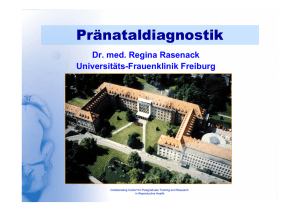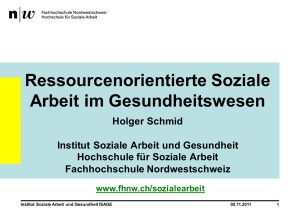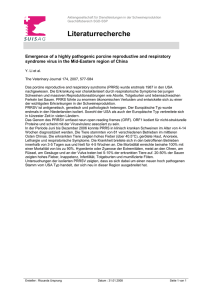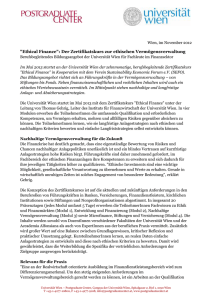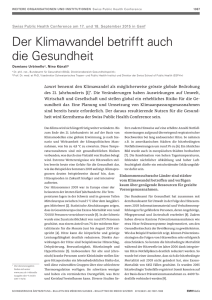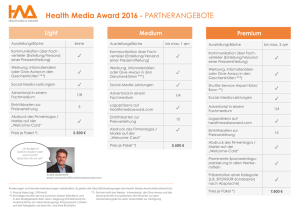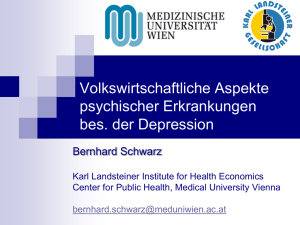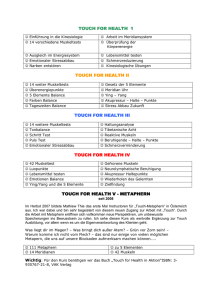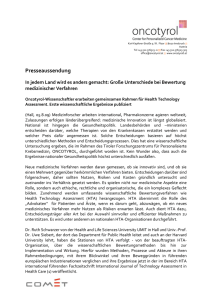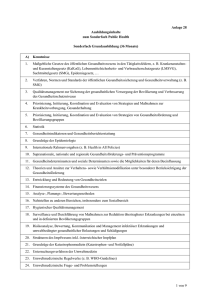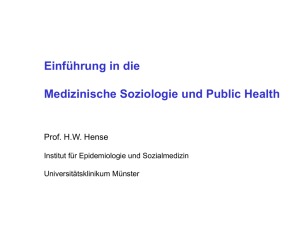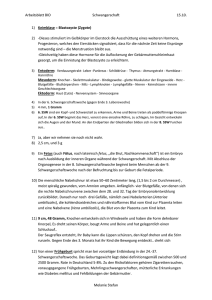Blutgruppen- Inkompatibilität Seminar Blutgruppen
Werbung
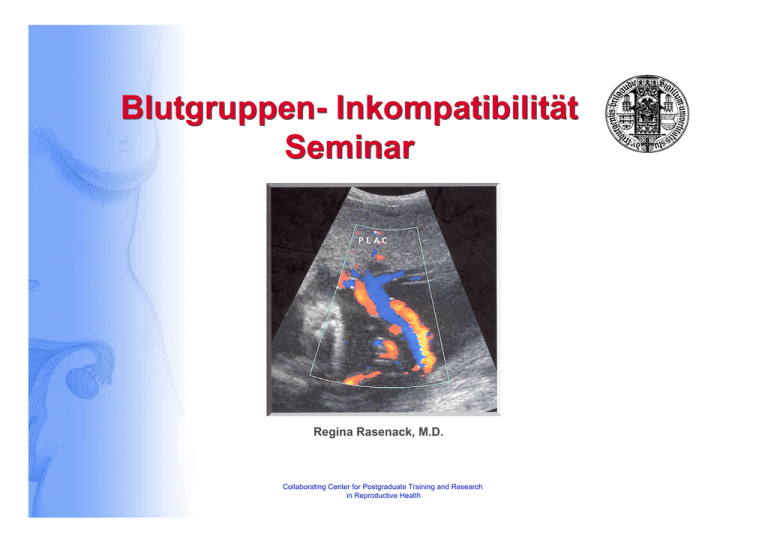
Blutgruppen- Inkompatibilität Seminar Regina Rasenack, M.D. Collaborating Center for Postgraduate Training and Research in Reproductive Health Blutgruppenunverträglichkeit 1.Fall: 30j. IV Gr/ I P, Blutgruppe, 0 Rh negativ, Z.n. Abruptio, Z.n. Sectio wegen BEL, Z.n. Abort, AK-Suchtest positiv, nach LP jetzt 34.SSW, Symptome: großer Bauch, Ziehen im Kreuz Collaborating Center for Postgraduate Training and Research in Reproductive Health Blutgruppenunverträglichkeit •Pränatal: gesteigerte Erythropoese mit Hepato-Spleno-Megalie Anämie Hydrops universalis bei Hb < 4g/dl Polyhydramnie •Postnatal: Anaemia neonatorum Ikterus gravis neonatorum Kernikterus (akut: Stupor, Hypotonie, Fieber, chronisch: Athetose, Spastik, Krämpfe, Hörverlust ) Collaborating Center for Postgraduate Training and Research in Reproductive Health Blutgruppen-Inkompatibilität Symptome •Pränatal: gesteigerte Erythropoese mit Hepato-Spleno-Megalie Anämie Hydrops universalis bei Hb < 4g/dl Polyhydramnie Herzinsuffizienz, IUFT Collaborating Center for Postgraduate Training and Research in Reproductive Health Blutgruppenunverträglichkeit Collaborating Center for Postgraduate Training and Research in Reproductive Health Blutgruppen-Inkompatibilität Symptome Postnatal: Anaemia neonatorum Ikterus gravis neonatorum Kernikterus Collaborating Center for Postgraduate Training and Research in Reproductive Health Blutgruppenunverträglichkeit Therapie: Entbindung, Fototherapie, eventuell: (AT)Transfusion Collaborating Center for Postgraduate Training and Research in Reproductive Health Hyperbilirubinämie beim Neugeborenen Fototherapie: blaues Licht (Wellenlänge 425-475 nm) wandelt Bilirubin in der Haut in nicht-toxische BilirubinIsomere um diese können ohne Glukuronidierung mit Galle und Urin ausgeschieden werden transepidermaler Wasserverlust steigt geringfügig an (um 2,1-2,5 ml/kg KG/d, Ausgleich durch Muttermilch) Nutzen einer erhöhten Flüssigkeitszufuhr ist für reife Neugeborene ohne Hämolyse unbewiesen Stornowski C, Hörnchen H (1981) Collaborating Center for Postgraduate Training and Research in Reproductive Health Hyperbilirubinämie beim Neugeborenen Collaborating Center for Postgraduate Training and Research in Reproductive Health Bilirunbin (mg/dl) Hyperbilirubinämie beim Neugeborenen 22 20 18 16 14 12 10 8 6 4 2 0 > 38 SSW 35 - 38 SSW 31 - 34 SSW 27 - 30 SSW < 27 SSW 0 1 2 3 4 Alter (Tage) Collaborating Center for Postgraduate Training and Research in Reproductive Health 5 Phototherapie Nebenwirkungen - Wässrige Stühle - Flüssigkeitsverlust - Temperatur - Instabilität - Ausschlag - Bronze baby Syndrom (konjugiertes Bilirubin) Collaborating Center for Postgraduate Training and Research in Reproductive Health Blutgruppenunverträglichkeit Collaborating Center for Postgraduate Training and Research in Reproductive Health Indikation zur Austauschtransfusion sofort postnatal, wenn • Bilirubin > 6 mg/dl • Hämatokrit < 35% • oder Bilirubin Anstieg > 0,5 pro Stunde über 6 h • oder Bilirubin > 16 mg/dl bis Tag 2 Komplikationen: Letalität < 3% Lunge: Embolien Herz: Arrhythmien, Herzstillstand Infektionen: Bakterien und Transfusionsbedingt Andere: Thrombosen, Gefässverletzung, Blutung … Collaborating Center for Postgraduate Training and Research in Reproductive Health number Austauschrate Universitäts-Kinderklinik Freiburg 187 30099 63 30 25014 39 30 16 200 13 14 7 1507 6 1 1002 2 3 503 1975 1976 1977 Anti-D-Prophylaxis 1978 1979 1980 1981 1982 1983 1984 1985 1986 1987 2000 2001 2002 2003 2004 0 1967 1967 bis 2004 1977 Phototherapy Phototherapy 1987 year Collaborating Center for Postgraduate Training and Research in Reproductive Health 1997 Blutgruppenunverträglichkeit 2.Fall: 28j. I Gr/ 0 P, , Blutgruppe A Rh positiv, Z.n. Herzvitium-OP vor 25 Jahren,, nach LP jetzt 20.SSW, AK-Suchtest positiv Collaborating Center for Postgraduate Training and Research in Reproductive Health Blutgruppen-Inkompatibilität Diagnostik Antikörpersuchtest positiv: 1. Schritt AK-Spezifizierung und Titerhöhe Blutgruppenbestimmung des Kindsvaters Blutgruppenbestimmung des Feten aus Amnionzellen (oder Mutterblut) Collaborating Center for Postgraduate Training and Research in Reproductive Health Blutgruppenunverträglichkeit Antikörpersuchtest, falls positiv: AKSpezifizierung und Titerhöhe Collaborating Center for Postgraduate Training and Research in Reproductive Health BlutgruppenInkompatibilität Diagnostik Antikörpersuchtest positiv: AntikörperSpezifizierung und Titerhöhe Collaborating Center for Postgraduate Training and Research in Reproductive Health Blutgruppenunverträglichkeit ab 13+7.SSW 0,9 mm E-Nadel ohne Lokalanästesie US-gesteuert Komplikationsrate 0,5% Antigenklärung, LileyBestimmung Collaborating Center for Postgraduate Training and Research in Reproductive Health Blutgruppenunverträglichkeit Liley I: keine oder geringe Hämolyse Liley II: leichte bis noch kompensierte schwere Hämolyse Liley III: akute Gefährdung Collaborating Center for Postgraduate Training and Research in Reproductive Health Nicht-invasive Pränataldiagnostik Blutgruppendiagnostik Collaborating Center for Postgraduate Training and Research in Reproductive Health Blutgruppenunverträglichkeit V max-Messung in der Arteria cerebri media (ACM) Collaborating Center for Postgraduate Training and Research in Reproductive Health Blutgruppenunverträglichkeit intraperitoneale Transfusion, 1963 unter Rö-Kontrolle (Liley), seit 1975 an UFKF V trans = ( SSW – 20) 10, seit 1983 US-gesteuert Collaborating Center for Postgraduate Training and Research in Reproductive Health Blutgruppenunverträglichkeit Intrauterine intravasale Transfusion: früher fetoskopisch, jetzt US-gesteuert (20G) V trans = V fetopl ( Hkt soll – Hkt ist) / Hkt trans Collaborating Center for Postgraduate Training and Research in Reproductive Health Blutgruppenunverträglichkeit Intrauterine Transfusion Risiken: •vorzeitige Wehen •vorzeitiger BS •Infektion •Sensibilisierung •maternale Kontamination •Probleme: HiWPl, Adipositas, unkoop. Pat. Collaborating Center for Postgraduate Training and Research in Reproductive Health Blutgruppenunverträglichkeit Intrauterine intravasale Transfusion: Collaborating Center for Postgraduate Training and Research in Reproductive Health Blutgruppenunverträglichkeit 3.Fall: 35j. III Gr/ II P, Blutgruppe A Rh negativ, nach LP jetzt 28.SSW, Wohlbefinden, AK-Suchtest negativ Collaborating Center for Postgraduate Training and Research in Reproductive Health Blutgruppenunverträglichkeit Rhesus-Prophylaxe: Anti D-Gabe nach Abort, Abruptio und Geburt eines (möglicherweise) Rh-positiven Kindes an rhnegative Mütter, die bisher nicht sensibilisiert sind Anti D-Gabe nach invasiver PD, Trauma, äußerer Wendung, Ab.imminens-Blutung und Anhalt für feto-maternale Transfusion Anti D-Gabe in der 28.-30.SSW nach erneut negativem AK-Suchtest Collaborating Center for Postgraduate Training and Research in Reproductive Health Blutgruppenunverträglichkeit Collaborating Center for Postgraduate Training and Research in Reproductive Health Blutgruppenunverträglichkeit Von den Rh-Positiven sind: Die Bevölkerung ist in Mitteleuropa: ca. 82 % Rh-positiv und ca. 18 % Rh-negativ 18 % 56 % 44 % ca. 44 % homozygot und ca. 56 % heterozygot 82 % Rh-positiv te heterozygot r DD Dd Rh dd DD Rh + Rh + Rh + Dd R h+ Rh Rh Rh + Rh Rh R h+ Rh dd Rh + Rh + er Rh + at ut homozygot V M Rh-negativ Rh + D as R h-M erkm al w ird autoso m al vererbt D er E rbgang ist do m inant für R h-positiv Collaborating Center for Postgraduate Training and Research in Reproductive Health Vielen Dank für die Aufmerksamkeit Collaborating Center for Postgraduate Training and Research in Reproductive Health
